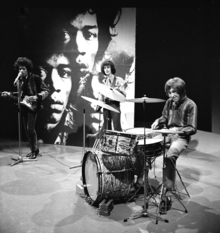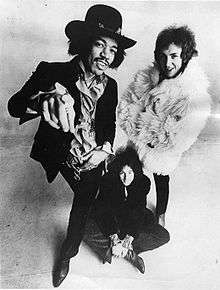The Jimi Hendrix Experience
| The Jimi Hendrix Experience | |
|---|---|
 The Jimi Hendrix Experience performing for Dutch television in 1967. From left to right: Jimi Hendrix, Noel Redding and Mitch Mitchell. | |
| Background information | |
| Origin | London, United Kingdom |
| Genres | |
| Years active | 1966–1969, 1970[6] |
| Labels | |
| Website | www.jimihendrix.com |
| Past members | |
The Jimi Hendrix Experience was an American-English rock band that formed in Westminster, London, in September 1966. Singer, songwriter, and guitarist Jimi Hendrix, bassist and backing vocalist Noel Redding, and drummer Mitch Mitchell comprised the group, which was active until June 1969. During this time, they released three studio albums and became one of the most popular acts in rock. In April 1970, Hendrix, Mitchell, and bassist Billy Cox performed and recorded until Hendrix's death on September 18, 1970. This later trio was sometimes billed as the "Jimi Hendrix Experience", but the title was never formalized.
Highly influential in the popularization of hard rock and psychedelic rock,[7] the Experience was best known for the skill, style, and charisma of their frontman, Jimi Hendrix. All three of the band's studio albums, Are You Experienced (1967), Axis: Bold as Love (1967) and Electric Ladyland (1968), were featured in the top 100 of the Rolling Stone list of The 500 Greatest Albums of All Time, at positions 15, 82 and 54 respectively. In 1992, the Jimi Hendrix Experience was inducted into the Rock and Roll Hall of Fame.
History
Jimi Hendrix arrived in England on September 24, 1966 and,[8] with his new manager and former Animals bassist, Chas Chandler, formed a backing band with bassist Noel Redding and drummer Mitch Mitchell.[9] Mitchell was a seasoned London drummer formerly with Georgie Fame and the Blue Flames. Hendrix chose Redding because of his attitude towards music and his hairstyle. Redding had been a guitar player until that time, but played bass in the band. The name "The Jimi Hendrix Experience" was coined by their business manager Michael Jeffery.[10] The first official appearance of "The Jimi Hendrix Experience" (invited by French singer Johnny Hallyday) was at the Novelty in Évreux, France, on October 13, 1966.[11] Six days later the band played their first UK gig at a private showcase at the Scotch of St James.

Though conceived as back-up band for Hendrix, the Experience, as a unit, gained fame and critical acclaim. Following the lead of Cream, the Jimi Hendrix Experience was one of the first groups to popularize the "power trio" format, which limited a rock band's line-up to guitar, bass and drums.[12] Hendrix combined lead and rhythm guitar styles and used special effects to modify his guitar sound such as feedback, and later the wah-wah pedal, to an unprecedented degree. Mitchell sometimes utilized jazz-influenced grooves, while Redding played simple bass lines that helped to anchor the band's sound.
Visually, they set the trend in psychedelic clothes and hairstyles (following his bandmates' Bob Dylan 1966-style hairdos, Mitchell got himself a permed copy). Their early performances, such as at The Bag O'Nails in London, were attended by some of the biggest names in the English rock scene, including members of the Beatles, the Rolling Stones, and guitarists Jeff Beck and Eric Clapton. The Who's Pete Townshend admitted, "[Jimi] changed the whole sound of electric guitar and turned the rock world upside down". Clapton agreed: "after Pete Townshend and I went to see him play, I thought that was it, the game was up for all of us, we may as well pack it in."[13] The group came to prominence in the US after the June 1967 Monterey Pop Festival,[14] one of the first major rock music festivals.[9] The band's performance ended with Hendrix famously setting his psychedelically painted Fender Stratocaster on fire.[10] After the festival they toured with the Monkees, but left the tour two weeks later, reportedly due to lack of audience response.[10]

With the Experience, Hendrix recorded several hit singles, such as "Hey Joe", "Purple Haze",[14] "The Wind Cries Mary", "Burning of the Midnight Lamp" and "All Along the Watchtower", and three successful albums: Are You Experienced, Axis: Bold as Love and Electric Ladyland. By April 1969, however, Hendrix's deteriorating relations with Redding were coming to a head, and he felt his musical development was hampered by the trio format.[15] The original group held together long enough to fulfill their existing engagements, culminating in the Denver Pop Festival on June 29, 1969. After hearing that Hendrix was planning to expand the Experience lineup without first consulting him, Redding quit the group and returned to England.
Hendrix and Mitchell experimented with a larger ensemble that included bassist Billy Cox. Sometimes referred to as Gypsy Sun and Rainbows, they performed at the Woodstock Festival in August 1969. By November, the lineup split and Hendrix returned to the trio format with Cox and drummer Buddy Miles. After recording the Band of Gypsys album and an aborted performance in January 1970, Miles was fired. Michael Jeffery (now Hendrix's only manager) called Redding and Mitchell about reforming the Experience. Both agreed to participate in a tour. Hendrix was open to having Mitchell rejoin, but reluctant to bring Redding back into the fold.

In early February 1970, Jeffery set up an interview with Rolling Stone magazine to announce the return of the group, published on March 19, 1970 in Rolling Stone as "J.H.: The End of a Beginning Maybe". Redding waited for weeks to hear back about rehearsals for the upcoming tour, and when he finally spoke with Mitchell's girlfriend, he learned that he had been replaced by Cox. Before the tour started, Hendrix called it "The Cry of Love Tour". The group itself was referred to as "Jimi Hendrix" and sometimes the "Jimi Hendrix Experience".
The trio toured and recorded in the US from April until August 1970. At the end of August, the European leg of the tour began, as a headliner at the Isle of Wight Festival 1970. During a break in the tour, Hendrix died on September 18, 1970.[9] In 1992, the Experience was inducted into the Rock and Roll Hall of Fame.[8] Noel Redding was found dead in his home in Ireland on May 11, 2003.[16] While touring in the US, Mitch Mitchell was found dead on November 12, 2008 in his room at the Benson Hotel in Portland, Oregon.[17]
Members
- Jimi Hendrix – lead vocals, guitars[18]
- Mitch Mitchell – drums
- Noel Redding – bass guitar, backing vocals[19]
- Billy Cox – bass, backing vocals (after Redding quit)[6]
Discography
- Are You Experienced (1967)
- Axis: Bold as Love (1967)
- Electric Ladyland (1968)
References
- ↑ "Noel Redding, 57; Bass Guitarist in Jimi Hendrix Band". Los Angeles Times. May 14, 2003. Retrieved April 19, 2015.
- ↑ Issitt, Micah L. (2009). Hippies: A Guide to an American Subculture. Greenwood Press. p. 42. ISBN 978-0-313-36572-0.
- ↑ Marten, Neville (2007). Guitar Heaven: The Most Famous Guitars to Electrify Our World. Collins Design. p. 10. ISBN 978-0-06-135944-6.
Cream and The Jimi Hendrix Experience were both three-piece blues-rock bands but, whereas Clapton with his Gibson SG or ES-335 made huge, dark, distorted tones, Hendrix's Strat was generally cleaner and sweeter.
- ↑ Potash, Chris, ed. (1996). The Jimi Hendrix Companion: Three Decades of Commentary. Schirmer Books. p. 66. ISBN 978-0-02864-609-1.
With drummer Mitch Mitchell and bassist Noel Redding [Jimi Hendrix] formed the Jimi Hendrix Experience. They were the first of the super high energy bands — the epitome of acid rock.
- ↑ Christopher Knowles (1 October 2010). The Secret History of Rock 'n' Roll. Simon and Schuster. p. 147. ISBN 978-1-57344-564-1.
- 1 2 3 During the April–September 1970 tour with bassist Billy Cox, the trio was sometimes referred to as the "Jimi Hendrix Experience"
- ↑ Whiteley, Sheila. "Progressive Rock and Psychedelic Coding in the Work of Jimi Hendrix". Popular Music. 9 (1): 37–60. doi:10.1017/s026114300000372x.
- 1 2 "The Jimi Hendrix Experience". Rock and Roll Hall of Fame. 2008. Retrieved March 19, 2009.
- 1 2 3 Unterberger, Richie; Westergaard, Sean. "Jimi Hendrix > Biography". AllMusic. Retrieved March 19, 2009.
- 1 2 3 Lawrence, Sharon (2005). Jimi Hendrix: The Intimate Story of a Betrayed Musical Legend (2006 ed.). New York City: HarperCollins. pp. 56, 78, 84. ISBN 0-06-056301-X.
- ↑ "Jimi Hendrix sites". www.musictrekker.com. Retrieved December 5, 2015.
- ↑ Saunders, William (2010) Jimi Hendrix London, Roaring Forties Press, ISBN 978-0-9843165-1-9
- ↑ Snow, Matt (November 2006), "3 is the Magic Number", Mojo Magazine, pp. 81–82.
- 1 2 Gilliland, John (1969). "Show 53 – String Man" (audio). Pop Chronicles. Digital.library.unt.edu.
- ↑ Mitchell, Mitch; Platt, John (1990). Jimi Hendrix: Inside the Experience. New York City: St. Martin's Press. pp. 88–96, 48–149. ISBN 978-0-312-10098-8.
- ↑ Vintage Amps Bulletin Board • View topic – Hendrix Bassist Noel Redding Dead At 57
- ↑ Jimi Hendrix drummer dies at 61 just days after tribute tour. Daily Mail. Retrieved June 16, 2012
- ↑ Hendrix also sometimes played bass, piano, harpsichord, glockenspiel, recorder, and makeshift kazoo
- ↑ Redding sometimes played guitar